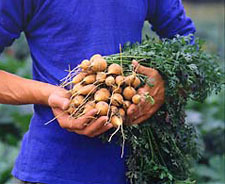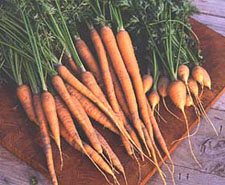Carrots are one of the best known root crops and a standard snack food, especially in fall and winter when other vegetables have long since gone. While we're all familiar with these orange roots, newer varieties are loaded with more healthful nutrients and feature unusual colors. The different colors are a throwback to the origins of the carrot. In their native Central Asia red, white, yellow, and purple carrots are more common than our traditional orange ones. Newer varieties feature these colors with the production and disease resistance we've come to expect in modern varieties.
Another great reason to grow and eat carrots is their nutritional content. These sweet roots are loaded with vitamin A and beta-carotene, known anti-oxidants and cancer-fighters. In fact, you only have to eat half a high-beta-carotene carrot variety to get your daily recommended dose of vitamin A.
So keep munching carrots this winter and come spring, plan for a bed or a container full of these colorful, healthy roots.
Here are the basics of carrot growing.
PlanningCarrots are a cool-season vegetable that loves to grow in well-drained soils. Carrots grow best in sand or sandy loam soils where they can stretch out their roots. However you can still get a good crop in clay soils by using raised beds.

Harvest carrots as soon as they have full color.
You don't need a big area to produce a lot of carrots. A small raised bed or even a container is a great place to grow a crop of roots. Carrots grow well in full sun or part shade. Start early (two to three weeks before your last frost date) and continue sowing seeds every three to four weeks into the fall. You'll have more carrots than you ever imagined.
Most varieties mature in approximately two months, but you can eat the thinnings when they are younger. If the ground doesn't freeze in your area, you can leave some varieties in the ground and harvest right through the winter.
Here are some of my favorite carrots to grow.
'Healthmaster Hybrid'- This 12-inch-long, late-season-maturing orange carrot has 30 percent more Vitamin A than other varieties.
'Little Fingers'- These 3- to 4-inch-long narrow orange roots have smooth skins and small cores. Good for container growing.
'Ithaca Hybrid'- This 7-inch-long orange variety is great eaten fresh or used for juicing.
'Purple Haze Hybrid'- This variety has a unique combination of heirloom color and hybrid production. It features purple skins and an orange core with a sweet flavor. The color does fade somewhat when cooked.

This Santa Claus "wannabe" loves a colorful display of carrots for the holidays.
'Rainbow Hybrid'- If you want a smattering of colorful carrots try 'Rainbow'. This hybrid features 8-inch-long white, yellow, and orange roots.
'Scarlet Nantes' - This heirloom variety is still considered a standard for flavor. The 6-inch-long orange roots are crisp, sweet, and tender, and have a small core.
'Thumbelina'- Perfect for container and window boxes, this orange variety features silver-dollar-sized, 2-inch diameter round roots that are great for cooking and roasting.
PreparationCreate raised beds in all but sandy soils, and rake rocks and debris out of the beds. Amend the soil with a 1-inch thick layer of compost before planting. Based on a soil test add any other nutrients as needed. However, don't add a high nitrogen fertilizer because it will cause the carrot roots to crack or become "hairy."
Carrots don't compete well with weeds and other crops, so grow them in their own area or in a container. However, to help loosen the soil and get better germination, consider planting radishes with the carrots. The radishes will germinate faster, breaking up the soil crust, giving the slower-germinating carrot seeds room to grow. By the time you finish harvesting the radishes, the carrots are beginning to fill in the space.
PlantingBroadcast carrot seed or make straight rows on top of a raised bed. Sprinkle seeds on top of loosened soil, about 4 per inch, and cover with a half-inch-thick layer of sifted soil or potting soil. In warm climates or when planting in summer, lay a floating row cover over the bed to keep the soil cool and moist during germination. For rows, make a ¼-inch-deep furrow, add a thin layer of compost in the bottom, and sow seeds. Space rows 18 inches apart.
If the small seeds are hard to handle, consider buying pelleted seeds. These are coated with a biodegradable material making the seeds larger and easier to handle, but doesn't affect germination.

Choose the right variety for your location. In deep soils grow long varieties. In containers or in heavy clay soil try short or round varieties.
Keep newly seeded beds moist. Seeds may take up to three weeks to germinate so be patient. A few weeks after germinating, thin the carrots to 1 to 2 inches apart. Thin again three to four weeks after so the roots are 3 to 4 inches apart. Keep the carrots well watered and weeded throughout the growing season. Add mulch, such as hay or straw, around the rows to preserve soil moisture and prevent weed growth.
Carrots are rarely bothered by pests. However, woodchucks and rabbits love the tops. Fence the garden or grow carrots under a floating row cover to fend off these four-legged critters. The tops of the roots may push out of the ground and turn green if exposed to the sun. To prevent this, cover any exposed roots with soil. Also, cut back on watering as the roots mature to prevent cracking.
HarvestingStart harvesting as soon as the roots are fully colored. The thinnings are great in salads. Wet the soil before harvesting so it's easier to pull up the roots. If the tops break when pulling out large roots, use a garden fork to gently pry them out. Roots left in the ground and exposed to cold weather tend to be sweeter. You can protect roots and harvest into the winter by mulching the bed with a 6- to 8-inch thick layer of hay or straw in fall. Harvest these winter roots as long as the ground remains unfrozen or until new growth starts in spring.
Other Great Carrot Stories: Charlie Nardozzi is an award winning, nationally recognized garden writer, speaker, radio, and television personality. He has worked for more than 30 years bringing expert gardening information to home gardeners through radio, television, talks, tours, on-line, and the printed page. Charlie delights in making gardening information simple, easy, fun and accessible to everyone. He's the author of 6 books, has three radio shows in New England and a TV show. He leads Garden Tours around the world and consults with organizations and companies about gardening programs. See more about him at Gardening With Charlie.
Charlie Nardozzi is an award winning, nationally recognized garden writer, speaker, radio, and television personality. He has worked for more than 30 years bringing expert gardening information to home gardeners through radio, television, talks, tours, on-line, and the printed page. Charlie delights in making gardening information simple, easy, fun and accessible to everyone. He's the author of 6 books, has three radio shows in New England and a TV show. He leads Garden Tours around the world and consults with organizations and companies about gardening programs. See more about him at Gardening With Charlie.
 Victory Seed Company has all the seeds you want for your best garden in 2024.
Victory Seed Company has all the seeds you want for your best garden in 2024.
For 25 years, the family-owned Victory Seed Company has provided the highest quality vegetable, herb and flower seeds to families across the country. We are passionate about providing you the best seeds available that give excellent germination, robust plants, and the harvest you want. With a catalog of over a thousand varieties, we have everything, and our prices are the kinds that we'd want to pay. We have hundreds of yesterday's heirloom vegetables, as well as today's award winning hybrid selections. Get to know us by visiting our website and browsing through our online vegetable seed catalog.